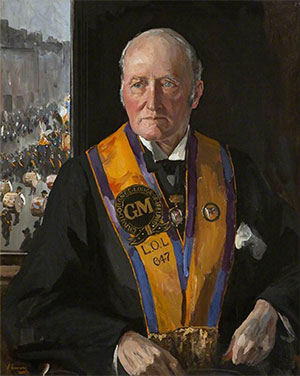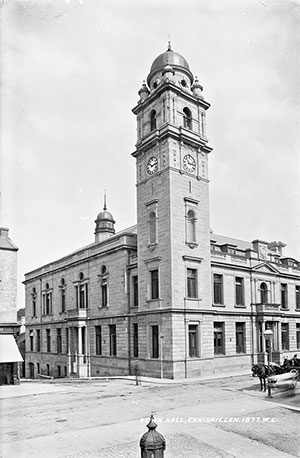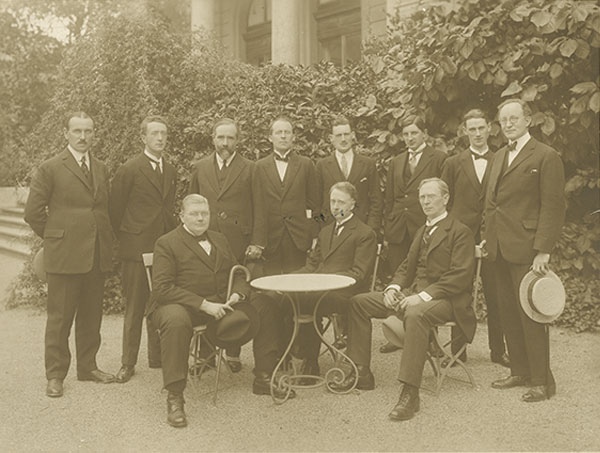Kevin O’Shiel and the North Fermanagh campaign
Published in 20th-century / Contemporary History, Features, Issue 6 (November/December 2018), Volume 26One of the most remarkable campaigns within this remarkable election.
Daniel Purcell

Above: O’Shiel’s Unionist opponent, sitting MP Sir Edward Mervyn Archdale. Despite his seemingly mild nature, Archdale’s victory speech inflamed the crowd, as he congratulated his ‘fellow Orangemen and fellow Loyalists’ for clearing the ‘rebels, traitors and pro-Germans out of loyal North Fermanagh’. (Alamy)
The 1918 general election was one of the most significant in Irish history. It provided a de facto mandate for Sinn Féin to pursue its republican agenda, signalled the electoral eclipse of the Irish Parliamentary Party (IPP) and in the north-eastern six counties reaffirmed Ulster Unionism in its opposition to Irish independence. Within this remarkable election the North Fermanagh battle between agreed nationalist candidate Kevin O’Shiel and Unionist candidate Edward Archdale was one of the most remarkable campaigns. This was one of the tightest results, with a margin of victory for Archdale of only 532 votes—4% of votes cast. It was by far the most Catholic constituency to elect a Unionist MP and was a victory of great symbolic importance in the county as a whole. In addition, the conduct of the campaign on the nationalist side was remarkable. In a finely balanced constituency they changed their candidate at the last moment, chose to campaign in heavily Protestant areas and ultimately paid the price.
Kevin O’Shiel and George Irvine
Owing to the significant unionist population in North Fermanagh, the IPP and Sinn Féin had decided to run an agreed candidate in the constituency. Sinn Féin proposed Enniskillen Protestant George Irvine, who had served as vice-commandant of the first battalion of the Volunteers and had fought in the Easter Rising. In doubtless his most ringing endorsement, his nomination was described by the unionist Impartial Reporter as ‘too grotesque for words!’ Irvine was deemed unacceptable, however, by the local Hibernian élites, who proposed Joseph Gillen instead. Realising that only one candidate could possibly win, a local plebiscite was held outside Catholic churches after Mass to determine the candidate. Irvine won comfortably. In response, local Hibernians made it known that they would not support Irvine in the election, with his parents’ ‘proselytising Protestantism’ given as a primary reason. Despite this faithlessness, it was Sinn Féin, who now had the initiative and the right to field the sole nationalist candidate, who agreed to withdraw Irvine. Initially Francis O’Duffy of Enniskillen was asked to run, but after his refusal the organisation put forward Kevin O’Shiel instead.

Above: Enniskillen Town Hall, where the count took place on New Year’s Eve 1918. (NLI)
This election was a minor phase in O’Shiel’s long and varied career. The clear, unsentimental and witty prose recounting the election occupies only twenty or so of the c. 1,000 pages of a BMH statement that runs from his Omagh childhood to his directorship of the North Eastern Boundary Bureau and membership of the Land Commission. A barrister before joining the Volunteers, he was Arthur Griffith’s election agent in the East Cavan by-election in 1918, which won him some prominence, and he was assigned to run as a Sinn Féin candidate in heavily unionist South Antrim in the general election. O’Shiel nervously accepted the North Fermanagh nomination; when asked whether the central organisation could do anything to help him in the campaign, he replied that he would only expect a republican funeral!
While O’Shiel was reluctant to take on another campaign and was disdainful of whatever ‘chicanery’ had seen Irvine dropped, he was convinced to run by Irvine himself. O’Shiel greatly respected Irvine and refused to stand without his consent. Irvine, for his part, strongly resented the ‘bigotry’ of the Hibernian contingent but recognised that without their acquiescence it was useless for him to run. He accepted his withdrawal and immediately set about securing a candidate ‘who stood for the principles of 1916 and Sinn Féin’. Before O’Shiel could be confirmed, however, he had to endure one final rite of passage—a meeting with the local Hibernian élite to pay his due respects. He was disdainful of the ceremony behind the organisation, in his memoirs describing the meeting house as ‘their County Grand Lodge or whatever it was called’. He poked fun, too, at the ponderous titles employed by the organisation—the ‘Tiler’ and ‘Porter’ who had to call him into the room where the members of the Order sat in their ‘not very exciting’ sashes. Despite this, O’Shiel’s speech was conciliatory, praising the achievements of the organisation in the county and making reference to figures of Fermanagh history such as the Maguires. His careful avoidance of any discussion of Sinn Féin’s actual ideology seemed to work, and the Hibernians agreed to support him as a candidate.
Despite this, there is little doubt that these election wranglings were a serious error on the part of the Hibernians, who had no chance of electing a candidate of their own. Irvine particularly seems to have been an excellent choice as candidate, described by Eda Sagarra as ‘ideal’ for such a mixed area. Moreover, O’Shiel’s attentions were now divided between two constituencies and he had already lost valuable time for campaigning. Unlike Irvine, O’Shiel was not local and had no particular connection to Fermanagh—a fact that was used against him by his opponent, sitting MP Edward Archdale.

Above: The agreed nationalist candidate for North Fermanagh in the 1918 general election, Kevin O’Shiel, pictured here (standing, fourth from left) with the Irish delegation to the League of Nations in 1923. (UCD Archives)
The campaign
Electoral violence was not uncommon in narrowly divided counties like Fermanagh and Tyrone. Following the election of the IPP’s Jeremiah Jordan to the South Fermanagh seat in 1910, there were clashes in Maguiresbridge between large crowds of nationalists and unionists. This was triggered by post-election celebrations, when a group of nationalists gathered to burn a tar barrel in celebration and local unionists afterwards attempted to break the barrel. Serious electoral violence, however, would not emerge until the Northern Ireland elections after partition.
Despite this, O’Shiel’s campaign struck a nerve with local unionists and passed off in far more hostile terms than his campaign in the unionist stronghold of South Antrim in the same election, to his own great surprise. This was partly due to Sinn Féin’s strategy in the 1918 election of canvassing in as many areas as they could, regardless of their political leanings, in contrast to the IPP, who had been content to contest only those localities they felt were winnable. Nor was O’Shiel a stranger to this; even his candidacy in the unwinnable South Antrim involved an intense campaign that ranged across the entire county. The same policy was followed in North Fermanagh; O’Shiel was strictly informed to ‘on no account, ignore the Protestant and Unionist districts’. Nor did he have any illusions as to why this was done, noting that ‘we were fundamentally a propagandist movement’.
This led to a number of tense encounters on the campaign trail. O’Shiel remembers one incident in particular during a campaign stop in Ballinamallard—a strongly Protestant town and one that neither O’Shiel nor his campaign manager, Dick Herbert, would otherwise have visited. Indeed, when O’Shiel told Herbert that it was their next stop, Herbert told him that he’d taken leave of his senses and proceeded to recount the numerous tales of the ‘anti-Catholic fury of the Ballinamallardians’.
In recognition of the danger, the visit took place in the afternoon specifically for the security of O’Shiel. It was hoped that the increased visibility would offer protection, as would the fact that the men of the town were away at work. Such proved to be the case, as O’Shiel found himself addressing a crowd of 200 women and children. Initially he was only interrupted with traditional unionist chants such as ‘To hell wi’ the Pope’s man’. Eventually three drummers, apparently having heard of the impudent national speaker, appeared and began playing loudly. This seemed to make the crowd more belligerent. According to O’Shiel, the women began taking ‘long hat-pins from their hair and made wicked stabs with them at us’. This was enough to cause Herbert and O’Shiel to flee the town ‘amidst a shower of stones and clods and a salvo of curses’.
Elsewhere on the trail Archdale made great use of the fact that O’Shiel was not from Fermanagh. In a speech in the same town he asked the crowd how many men his opponent had ever employed. He pointed out his own sterling record as an employer, as well as emphasising his own credentials as a ‘Fermanagh man born and bred’. His language during the campaign was typical of a Unionist candidate—Sinn Féin and O’Shiel were ‘more invidious than the Kaiser’.
Election riot
The day of the count on New Year’s Eve 1918 passed off largely cordially between O’Shiel and Archdale. While there was a slim unionist majority on the electoral register, nationalists held out hopes of upsetting that with a stronger turnout (although it was noted that the Spanish ’flu had spread to Fermanagh and had mostly confined itself to the Catholic community). Despite this, initial counts pointed towards a nationalist victory, and this so dispirited Archdale that O’Shiel took pity on him. To O’Shiel he seemed ‘a mildly spoken, gentle old chap’, and his anxiety about the election result (and the subsequent loss of income) prompted O’Shiel to attempt to comfort him, telling him that the solid Unionist votes were yet to come in and that he had time to make a comeback.
This proved to be the case, as the votes from Lisbellaw, Kesh and other unionist areas came in and Archdale secured victory. Despite O’Shiel’s compassion for the man and his own seemingly mild nature, Archdale’s victory speech inflamed the crowd, as he congratulated his ‘fellow Orangemen and fellow Loyalists’ for clearing the ‘rebels, traitors and pro-Germans out of loyal North Fermanagh’. The local Anglican church was broken into, the curate overpowered and the bells rung in celebration. (It would later emerge that the men who broke in were not even Anglicans themselves but Presbyterians.)
O’Shiel himself was taken aback:
‘Were that voice and those words, the voice and words of the nervous, mild little man in whose mellow company I had spent the day? It was a violent, rabble rousing, bitter speech, such as would be made by the average semi-educated Orange mob orator.’
He later recorded his fear about whether he would be able to escape with his life. He was eventually rescued by a large crowd of nationalist soldiers, who began brawling with the unionist supporters and escorted O’Shiel to his hotel.
While the strength of this reaction from Fermanagh unionists to their victory might seem surprising now, even at the time O’Shiel understood it:
‘The great fear of the Unionists and their great relief … are very understandable today; for, had I won, it would have meant that the entire parliamentary representation of the County Fermanagh would have been held by Sinn Féin—in other words, by anti-partitionists of the most uncompromising type.’
Fermanagh unionists were in a precarious position in 1918. While plans for a partitioned Ireland, accepted by the Ulster Unionist Council in 1916, had included the county in the putative northern state, these had not been followed through and before any new solution was reached there existed considerable anxiety in the community. Most of this anxiety focused on the unavoidable issue of the county’s Catholic population. While Cavan, Monaghan and Donegal had obvious Catholic majorities of roughly 82%, 75% and 79%, in Fermanagh and Tyrone the numbers were much closer, with the Catholic majority in Fermanagh being only 56%. Unlike Tyrone, where the more concentrated distribution of unionists allowed William Coote to win the South Tyrone election with a majority of over 5,000, in Fermanagh unionists were more evenly distributed and consequently did not hold an outright majority in either constituency. South Fermanagh was 62% Catholic and North Fermanagh 51%. Consequently, the fear of ending up with no parliamentary representation and therefore being grouped with Cavan, Monaghan and Donegal and put at risk of exclusion from a northern state was very strong and most keenly felt in the 1918 election, the first under a greatly expanded franchise.
The 1918 election in North Fermanagh sat on two boundaries between different Irelands: old and new, and North and South. It is interesting not just for the manner in which it was fought and in which O’Shiel was brought in at the last minute but also for what it meant to the Catholics and Protestants of the county, even if that intensity and sense of uncertainty have been lost under the veneer of a partition settlement nearly a century old.
Daniel Purcell is a Ph.D student at Trinity College Dublin.
FURTHER READING
P. Livingstone, Fermanagh story (Clogher, 1969).
Kevin O’Shiel, Bureau of Military History statement Ws. 1770
(http://www.bureauofmilitaryhistory.ie).
E. Sagarra, Kevin O’Shiel: Tyrone nationalist and Irish state-builder (Dublin, 2013).
















